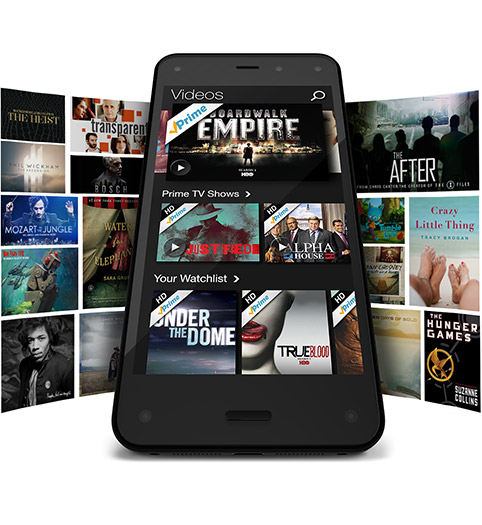Amazon Announces Fire Phone to Heat Up Mobile
The long-rumored Amazon phone is closing in on reality. Dubbed the Amazon Fire Phone, it will be available on 25 July 2014, but is available for pre-order now. It is exclusive to AT&T, and the 32 GB model costs $199 with a two-year contract, or $649 without a contract. There is also a 64 GB version available for $100 more.
As always, Amazon is offering powerful incentives. In this case, the Fire Phone comes with a free year of Amazon Prime, which grants free two-day shipping on thousands of items, plus free streaming of select TV shows and movies, free book borrowing, and ad-free streaming of over a million songs (a $99 value). In addition, the Fire Phone offers unlimited cloud storage for every photo you take with the device (Amazon’s standard Cloud Drive pricing is $0.50 per gigabyte per year).
The technical specs are impressive: a 2.2 GHz quad-core Snapdragon 800 processor, 2 GB of RAM, an Adreno 330 graphics processor, a 4.7-inch LCD with 1280-by-720 resolution, a 13-megapixel rear-facing camera with a f/2.0 aperture and optical image stabilization, a 2.1 megapixel front-facing camera, stereo speakers, and a battery that offers up to 22 hours of talk time or 11 hours of video playback. As with Amazon’s Kindle Fire tablets, it runs Fire OS, a customized version of the Android operating system.
Both the front- and rear-facing cameras capture 1080p video at 30 frames per second. The cameras also feature intelligent HDR, which suggests when to turn the feature on. There are also settings to take panoramic shots, burst shots, and even a lenticular mode to take 3D pictures.
The Fire Phone’s flashiest feature is Dynamic Perspective, which takes advantage of four front-facing sensors to track your face, making it possible to display everything in 3D. You’ll be able to tilt and swivel the phone to access menus, peek around maps, and access other features. Amazon claims that you will be able to scroll through Web pages and other content without touching the screen.
Another impressive (or depressing, if you worry about local retailers) feature is Firefly, which uses the camera to identify bar codes, movies, TV shows, and music, and lets you purchase associated items instantly from Amazon. Firefly is activated by a dedicated physical button on the Fire Phone, making shopping with Amazon even easier than it was with separate Amazon apps before — publishing veteran Joe Wikert believes Firefly will become increasingly important to the content industry. In addition to shopping, Firefly also recognizes email addresses, Web URLs, and phone numbers, and lets you take a variety of actions based on the
recognized text.
Novices, or anyone who has trouble with technology, will appreciate Mayday, which was originally seen in the Kindle Fire HDX tablet. Press the Mayday button and in less than 15 seconds, you’ll be in a video chat with an Amazon expert who can show you how to use the phone via remote control. Anecdotal reviews have given high marks to Mayday on the Kindle Fire HDX.
The Fire Phone also includes a set of earbuds, which look similar to Apple’s EarPods, including an inline remote. But Amazon’s earbuds are unique in that they feature a flat, tangle-resistant cable, and the buds themselves are magnetic, so they stick together while stashed away, also preventing tangles.
Amazon’s Fire Phone boasts some notable technology and will likely benefit from Amazon’s promotion, but it doesn’t break significant new ground. Like the Kindle and the Fire TV, one of the Fire Phone’s primary design objectives is to make it ever easier to buy content and products from Amazon (for our review of the Fire TV, see “Fire Watch with Me: Amazon Fire TV vs. Apple TV,” 13 May 2014).
This shouldn’t be surprising: Amazon’s goal is to enmesh you in their purchasing ecosystem, just as Apple’s is to entice you to spend all your time and money on Apple products and associated content, and Google’s is to encourage usage of services that will increase views of highly targeted ads.

Good review and this quote is one of the best summaries I've seen in years, "Amazon’s goal is to enmesh you in their purchasing ecosystem, just as Apple’s is to entice you to spend all your time and money on Apple products and associated content, and Google’s is to encourage usage of services that will increase views of highly targeted ads."